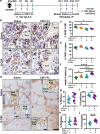Stable colony-stimulating factor 1 fusion protein treatment increases hematopoietic stem cell pool and enhances their mobilisation in mice
- PMID: 33402221
- PMCID: PMC7786999
- DOI: 10.1186/s13045-020-00997-w
Stable colony-stimulating factor 1 fusion protein treatment increases hematopoietic stem cell pool and enhances their mobilisation in mice
Abstract
Background: Prior chemotherapy and/or underlying morbidity commonly leads to poor mobilisation of hematopoietic stem cells (HSC) for transplantation in cancer patients. Increasing the number of available HSC prior to mobilisation is a potential strategy to overcome this deficiency. Resident bone marrow (BM) macrophages are essential for maintenance of niches that support HSC and enable engraftment in transplant recipients. Here we examined potential of donor treatment with modified recombinant colony-stimulating factor 1 (CSF1) to influence the HSC niche and expand the HSC pool for autologous transplantation.
Methods: We administered an acute treatment regimen of CSF1 Fc fusion protein (CSF1-Fc, daily injection for 4 consecutive days) to naive C57Bl/6 mice. Treatment impacts on macrophage and HSC number, HSC function and overall hematopoiesis were assessed at both the predicted peak drug action and during post-treatment recovery. A serial treatment strategy using CSF1-Fc followed by granulocyte colony-stimulating factor (G-CSF) was used to interrogate HSC mobilisation impacts. Outcomes were assessed by in situ imaging and ex vivo standard and imaging flow cytometry with functional validation by colony formation and competitive transplantation assay.
Results: CSF1-Fc treatment caused a transient expansion of monocyte-macrophage cells within BM and spleen at the expense of BM B lymphopoiesis and hematopoietic stem and progenitor cell (HSPC) homeostasis. During the recovery phase after cessation of CSF1-Fc treatment, normalisation of hematopoiesis was accompanied by an increase in the total available HSPC pool. Multiple approaches confirmed that CD48-CD150+ HSC do not express the CSF1 receptor, ruling out direct action of CSF1-Fc on these cells. In the spleen, increased HSC was associated with expression of the BM HSC niche macrophage marker CD169 in red pulp macrophages, suggesting elevated spleen engraftment with CD48-CD150+ HSC was secondary to CSF1-Fc macrophage impacts. Competitive transplant assays demonstrated that pre-treatment of donors with CSF1-Fc increased the number and reconstitution potential of HSPC in blood following a HSC mobilising regimen of G-CSF treatment.
Conclusion: These results indicate that CSF1-Fc conditioning could represent a therapeutic strategy to overcome poor HSC mobilisation and subsequently improve HSC transplantation outcomes.
Keywords: Colony-stimulating factor 1; HSC mobilisation; Hematopoietic stem cells; Macrophages.
Conflict of interest statement
The authors declare no competing interests.
Figures







Similar articles
-
Effect of FLT3 ligand and granulocyte colony-stimulating factor on expansion and mobilization of facilitating cells and hematopoietic stem cells in mice: kinetics and repopulating potential.Blood. 1998 Nov 1;92(9):3177-88. Blood. 1998. PMID: 9787154
-
Mesenchymal stromal cells induce a permissive state in the bone marrow that enhances G-CSF-induced hematopoietic stem cell mobilization in mice.Exp Hematol. 2018 Aug;64:59-70.e2. doi: 10.1016/j.exphem.2018.05.002. Exp Hematol. 2018. PMID: 29775645
-
Peripheral blood progenitor cells mobilized by recombinant human granulocyte colony-stimulating factor plus recombinant rat stem cell factor contain long-term engrafting cells capable of cellular proliferation for more than two years as shown by serial transplantation in mice.Blood. 1995 May 1;85(9):2303-7. Blood. 1995. PMID: 7537109
-
Cellular players of hematopoietic stem cell mobilization in the bone marrow niche.Int J Hematol. 2017 Feb;105(2):129-140. doi: 10.1007/s12185-016-2162-4. Epub 2016 Dec 10. Int J Hematol. 2017. PMID: 27943116 Review.
-
The role of granulocyte colony-stimulating factor in mobilization and transplantation of peripheral blood progenitor and stem cells.Cytokines Mol Ther. 1995 Dec;1(4):249-70. Cytokines Mol Ther. 1995. PMID: 9384679 Review.
Cited by
-
Neurogenic Heterotopic Ossifications Recapitulate Hematopoietic Stem Cell Niche Development Within an Adult Osteogenic Muscle Environment.Front Cell Dev Biol. 2021 Mar 5;9:611842. doi: 10.3389/fcell.2021.611842. eCollection 2021. Front Cell Dev Biol. 2021. PMID: 33748104 Free PMC article. Review.
-
Comparison of the efficacy of hematopoietic stem cell mobilization regimens: a systematic review and network meta-analysis of preclinical studies.Stem Cell Res Ther. 2021 May 29;12(1):310. doi: 10.1186/s13287-021-02379-6. Stem Cell Res Ther. 2021. PMID: 34051862 Free PMC article.
-
Hemolysis dictates monocyte differentiation via two distinct pathways in sickle cell disease vaso-occlusion.J Clin Invest. 2023 Sep 15;133(18):e172087. doi: 10.1172/JCI172087. J Clin Invest. 2023. PMID: 37490346 Free PMC article.
-
New Insights into Hematopoietic Stem Cell Expansion to Stimulate Repopulation of the Adult Blood System for Transplantation.Life (Basel). 2022 May 11;12(5):716. doi: 10.3390/life12050716. Life (Basel). 2022. PMID: 35629383 Free PMC article. Review.
-
Platelet-derived circulating soluble P-selectin is sufficient to induce hematopoietic stem cell mobilization.Stem Cell Res Ther. 2023 Oct 20;14(1):300. doi: 10.1186/s13287-023-03527-w. Stem Cell Res Ther. 2023. PMID: 37864264 Free PMC article.
References
-
- Perseghin P, Terruzzi E, Dassi M, et al. Management of poor peripheral blood stem cell mobilization: Incidence, predictive factors, alternative strategies and outcome. A retrospective analysis on 2177 patients from three major Italian institutions. Transfus Apheresis Sci. 2009;41(1):33–37. doi: 10.1016/j.transci.2009.05.011. - DOI - PubMed
Publication types
MeSH terms
Substances
LinkOut - more resources
Full Text Sources
Other Literature Sources
Medical
Research Materials
Miscellaneous

